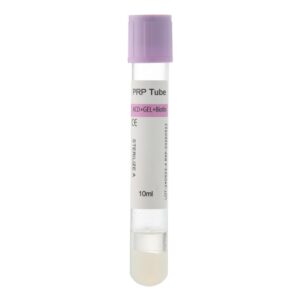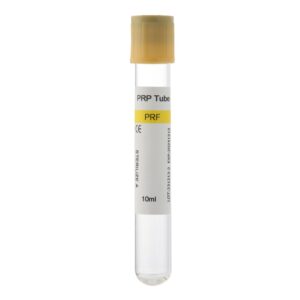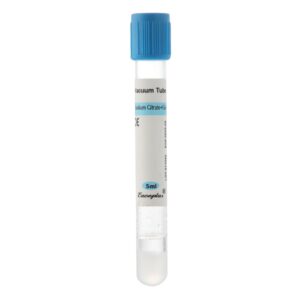Platelet-rich plasma (PRP) treatment is revolutionizing various fields of medicine, from orthopedics to dermatology, by utilizing the patient’s own blood to promote healing and rejuvenation. However, one of the most crucial aspects of ensuring a successful PRP treatment lies in the selection of the correct PRP tube. The choice of tube can directly influence the efficacy of the treatment, the quality of the plasma, and even patient outcomes.
For laboratory technicians and medical consumables distributors, selecting the right PRP tube can be daunting, given the multitude of options available on the market.
What Is PRP and Why Tube Selection Matters
PRP therapy is based on the principle of concentrating platelets and growth factors from a small sample of the patient’s blood, which is then reinjected to promote healing. The process begins with blood collection, followed by the separation of plasma components through centrifugation. Here, the tube used to collect and process the blood plays a critical role.
Choosing the right PRP tube is important because not all tubes are designed to separate blood components as efficiently as others. High-quality tubes ensure better yield of platelet-rich plasma, while poorly designed tubes may result in poor separation, inadequate platelet concentration, or contamination. Furthermore, the materials and additives used in the tube can influence the outcome of the PRP treatment, affecting not just the plasma’s quality but also patient safety and comfort.

Key Factors to Consider When Selecting a PRP Tube
- Material Quality: The material of the PRP tube must be of high quality to prevent any risk of contamination. They generally prefer medical-grade plastic or glass to ensure the safety and integrity of the blood sample.
- Additives and Anticoagulants: Most PRP tubes contain specific additives or anticoagulants to prevent the blood from clotting before centrifugation. Some tubes are coated with substances that help in the separation of plasma and red blood cells more effectively. It’s crucial to choose a tube with the right additives for your specific PRP protocol.
- Centrifugation Compatibility: Different PRP protocols require different centrifugation speeds and durations. The tube you select should be compatible with the recommended centrifuge settings to ensure proper plasma separation. Low-quality tubes may deform or break during the process, which can compromise the quality of the PRP.
How PRP Tubes Work: The Science Behind Platelet-Rich Plasma Collection
Once you have selected the right PRP tube, following the correct steps for blood collection, centrifugation, and application is essential for maximizing the therapeutic potential of the PRP treatment.
- Blood Collection: Draw the patient’s blood using a sterile syringe and transfer it into the selected PRP tube. Ensure that the tube is filled to the correct level and that the anticoagulant has adequately mixed with the blood.
- Centrifugation: The tube is then placed in a centrifuge machine where it is spun at the specified speed and duration. The centrifugal force separates the blood components based on their density, with the plasma moving to the top and red blood cells at the bottom.
- Plasma Extraction: After centrifugation, the PRP (the platelet-rich portion) is carefully extracted. This plasma is then ready for reinjection into the patient at the targeted area, whether it’s for tissue regeneration, joint healing, or cosmetic rejuvenation.
- Application: The final step involves injecting the PRP into the designated treatment area. The concentration of platelets and growth factors promotes healing and accelerates tissue regeneration, whether it’s for skin rejuvenation, hair restoration, or orthopedic recovery.

Applications of PRP Treatment
PRP therapy has gained immense popularity across various medical fields due to its ability to accelerate healing and tissue regeneration. Depending on the specific treatment protocol and the area of application, the PRP preparation and tube selection may vary. Below are some of the most common uses of PRP:
Orthopedic and Sports Medicine
In orthopedics, PRP is commonly used to treat tendon injuries, ligament sprains, and joint arthritis. By promoting tissue repair and regeneration, PRP can significantly reduce pain and improve mobility. In sports medicine, athletes frequently turn to PRP for healing injuries such as muscle strains, ligament tears, and tendonitis, helping them recover faster and return to their activities.
Dermatology and Aesthetic Treatments
In dermatology, PRP is used for skin rejuvenation, reducing wrinkles, and improving skin texture and tone. The growth factors in PRP stimulate collagen production, promoting youthful and radiant skin. It’s also a popular treatment for hair restoration, especially in cases of androgenic alopecia (hair loss), where PRP injections help stimulate hair follicles and improve hair growth.
Dental Medicine
In dentistry, PRP is used to promote healing after dental surgeries, including tooth extractions, implants, and gum surgeries. The rich concentration of platelets helps accelerate tissue regeneration, reducing healing time and minimizing complications.
Wound Healing and Burn Treatment
For patients suffering from chronic wounds or burns, PRP treatment accelerates healing by increasing cell proliferation, collagen formation, and tissue regeneration. This is particularly useful in treating diabetic ulcers and other difficult-to-heal wounds.
Why Choosing a Reliable PRP Tube Supplier Matters
A high-quality PRP tube is only as effective as the supplier that provides it. With so many options on the market, it’s important to choose a supplier that offers tubes designed with optimal performance in mind. At Siny PRP, we understand the importance of both product quality and customer service, and we are dedicated to providing laboratories and medical professionals with the best PRP tubes available.
Choosing a supplier like Siny PRP ensures that you are investing in tubes that are manufactured to the highest standards, rigorously tested for performance, and compatible with various PRP protocols. Additionally, a trusted supplier offers valuable support when you have questions or need assistance in selecting the right product.
Key Considerations and Precautions When Using PRP Tubes
While PRP therapy is a safe and highly effective treatment, there are several considerations and precautions to keep in mind when working with PRP tubes to ensure optimal results and patient safety.
Tube Compatibility with Centrifuge Settings
As mentioned earlier, not all PRP tubes are created equal. Ensure that the tube you select is compatible with your centrifuge’s settings. Using the wrong tube or centrifuge settings can result in poor separation of plasma and blood components, reducing the effectiveness of the treatment.
Avoiding Over-centrifugation or Under-centrifugation
The centrifugation time and speed must be precise to ensure that the plasma is separated correctly. Over-centrifuging can lead to the loss of important growth factors, while under-centrifuging can result in an incomplete separation, leaving behind unwanted blood components such as red blood cells. Always adhere to the recommended protocol for the PRP tube you are using.
Storage and Shelf Life of PRP Tubes
It’s essential to check the expiry date of PRP tubes before use. Expired tubes may not function as effectively in blood collection or plasma separation, leading to compromised results. Always store the tubes as instructed by the manufacturer to prevent any degradation of materials.
Patient-Specific Protocols
Different patients may have different needs based on their medical condition, age, or treatment goals. Some may require a higher concentration of platelets, while others may need a lower concentration. Ensure that you are following the correct protocol for each individual patient’s needs to maximize the therapeutic effects of the PRP therapy.
FAQs
1. What makes Siny PRP tubes different from other brands?
We manufacture Siny PRP tubes using the highest quality materials and design them for superior separation efficiency. We rigorously test our tubes for consistency and compatibility with different centrifuge protocols, ensuring reliable outcomes for your PRP treatments.
2. Can I use any type of PRP tube for all applications?
No. Different applications may require different PRP concentrations, and thus, selecting the right tube for your treatment protocol is crucial. Be sure to consult with the manufacturer or supplier for advice on the optimal tube for your specific procedure.
3. How do I know if I am using the right centrifugation speed and time?
The correct centrifugation speed and time will depend on the tube and the PRP protocol. Always refer to the manufacturer’s guidelines for both the tube and centrifuge settings to achieve the best results.
4. Are Siny PRP tubes compatible with all centrifuge machines?
Yes, We designed our PRP tubes to be compatible with most centrifuge machines. However, we recommend consulting your centrifuge’s specifications for confirmation.
Summary
As you can see, the selection of the right PRP tube is a key factor in ensuring the success of your PRP treatments. By choosing high-quality tubes and following the correct procedures, you can provide patients with safe and effective treatments that lead to optimal outcomes. Partnering with a reliable supplier like Siny PRP will ensure you always have access to the best products on the market.





